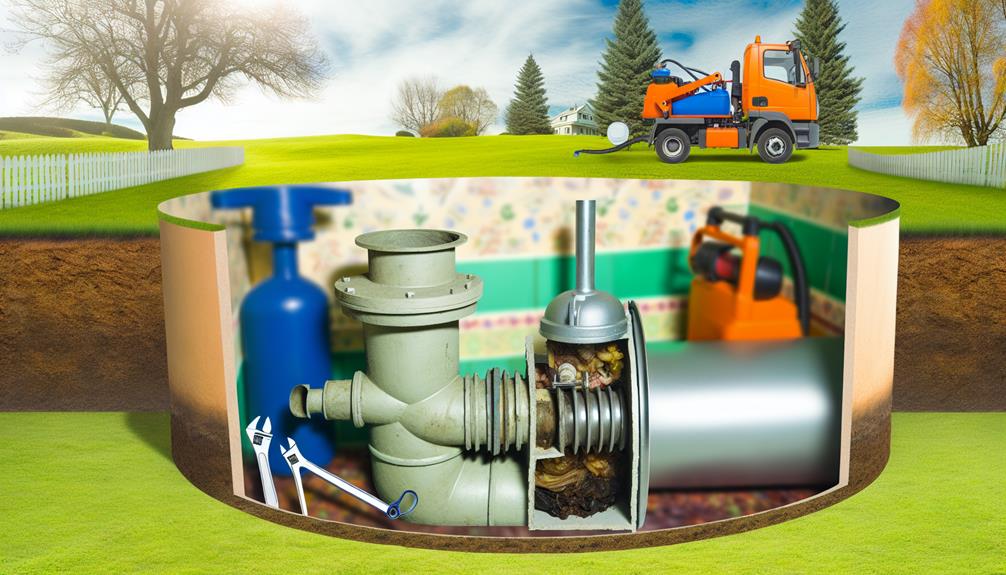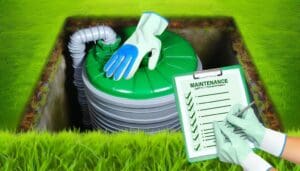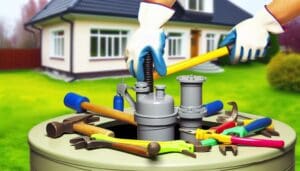Discover how to protect your septic system from breakdown with...
Read MoreYou & Your Septic Tank
Why Are DIY Fixes Essential for Septic Tank Pumping?
Our professional septic service team offers comprehensive septic tank pumping services to keep your system running smoothly. Get a FREE Quote Today.

Why Are DIY Fixes Essential for Septic Tank Pumping?
Imagine you’re cooking a lavish dinner for a group of friends, and right in the middle of it, your kitchen sink clogs. Frustrating, isn’t it?
Now, picture a similar situation, but this time it’s your septic tank that’s backed up. Both scenarios are disruptive, but one can have far more serious consequences for your home.
You see, the importance of septic tank pumping is a bit like cooking; it’s not just about the final result, but also about the process and the maintenance involved.
Knowing a few DIY fixes can not only help you prevent and address minor issues but can also save you some hefty repair bills down the line.
So, wouldn’t you be interested to know more about how this works?
Key Takeaways
- Regular DIY maintenance tasks such as inspecting and pumping the septic tank can prevent system failure and costly repairs.
- DIY fixes for minor septic tank issues save money on professional services and allow for timely identification and resolution of problems.
- Learning DIY septic tank pumping techniques empowers homeowners to take control of their system and promote sustainable practices.
- While DIY fixes are suitable for minor issues, professional septic services are necessary for major repairs, drainfield repairs, and dealing with legal issues.
Understanding Septic Tank Pumping

To fully grasp the importance of septic tank pumping, you must first understand how your septic system functions and why regular maintenance is critical. Your septic system is primarily composed of a tank and a drain field. Wastewater from your home flows into the tank, where solid waste settles at the bottom, forming a sludge layer. The liquid waste or effluent then flows out into the drain field for further treatment.
Now, let’s talk about ‘Pumping Frequency’ and ‘Septic Capacity’. These two factors are closely related. The capacity of your septic tank dictates how frequently it needs to be pumped. For instance, a smaller tank will fill up faster, requiring more frequent pumping. On the other hand, a larger tank can accommodate more waste, thereby reducing the pumping frequency.
Ignoring the pumping frequency can lead to an overfilled tank, causing system failure and potentially severe environmental damage. Therefore, it’s crucial to understand your septic system’s capacity and maintain a suitable pumping schedule.
Regular pumping not only prevents system failure but also extends the lifespan of your septic system. Remember, a well-maintained septic system is key to a healthy and happy home.
Identifying Common Septic Tank Problems
Identifying common septic tank problems is a vital skill for homeowners, as early detection can prevent minor issues from escalating into major, costly repairs. One of the most glaring signs of a problem is a foul odor. If you detect an unusual stench, it’s time to engage in septic smell identification. This process can help you determine whether the smell is due to a full tank or a failure in the septic system.
Moreover, don’t underestimate the impact of tank material degradation. Over time, the materials used to construct your tank can deteriorate, which can lead to leaks and other issues. Concrete tanks can develop cracks, while steel tanks can rust and corrode. If you notice water pooling around the tank area or lush, green grass growing directly above it, it’s likely that your tank is leaking.
Essential DIY Fixes for Septic Troubles
Having pinpointed potential issues with your septic tank, you’re well-equipped to tackle some essential DIY fixes that can mitigate these troubles.
First, regular pumping is a must, typically every 3-5 years, depending on your tank size and household usage.
Don’t ignore slow drains. They’re often a sign of clogging in your septic system. A simple DIY fix involves using a plumber’s snake to unclog drains and pipes. However, refrain from using harsh chemical drain cleaners, as they can damage your septic system.
Your septic system lifespan can be remarkably extended by watching what goes down your drains. Non-biodegradable items like diapers, wipes, cooking grease, and coffee grounds can wreak havoc on your system’s functionality.
For drain field issues, ensure that it’s not over-saturated. Diverting excess water from the field can fix this issue. Also, avoid planting trees near the field as roots can damage the system.
Lastly, consider implementing a regular maintenance schedule. Regular inspections can reveal minor issues before they become major problems.
These DIY troubleshooting tips not only save you money but also significantly improve your septic system lifespan. But remember, for serious issues, don’t hesitate to call a professional.
Safety Precautions for DIY Septic Repair
When undertaking DIY repairs on your septic tank, it’s crucial to prioritize safety.
First, gain a comprehensive understanding of potential septic system hazards to avoid accidents.
You’ll also need to equip yourself with the right protective gear and familiarize yourself with emergency response procedures should things go awry.
Understanding Septic System Hazards
Before diving into DIY septic system repairs, it’s essential that you comprehend the potential hazards to ensure your safety. Hazardous waste handling is a critical concern. Septic tanks contain harmful pathogens that can cause illness if not properly managed. Wear protective clothing, gloves, and masks when working on your system.
Another vital facet is the environmental impact assessment. A faulty septic system can contaminate local water sources, posing a risk to both human and ecological health. Be mindful of signs of system failure like lush vegetation or sewage odor around the drain field.
Moreover, ensure you’re familiar with local regulations concerning septic system repairs. Non-compliance can lead to hefty penalties. Always prioritize your safety and the environment in your DIY endeavors.
Protective Gear for Repairs
To ensure you’re adequately protected during DIY septic system repairs, it’s crucial to wear specific protective gear designed to guard against potential hazards. Your gear selection should prioritize safety equipment that offers comprehensive protection.
Here’s a list of essential items to consider:
- Heavy-duty Gloves: Protects hands from harmful substances and sharp objects.
- Safety Goggles: Prevents harmful splashes or debris from entering your eyes.
- Respirator Mask: Shields you from inhaling hazardous gases or dust.
- Full-body Coveralls: Keeps your body covered, minimizing direct contact with waste.
- Steel-toe Boots: Protects your feet from heavy falling objects and punctures.
Emergency Response Procedures
Even with the best protective gear, it’s crucial you’re well-versed in emergency response procedures to handle any unexpected incidents during your DIY septic repair. Accidents can occur, and crisis management is key.
Understand the emergency protocols of your area. Know the contact details of your local emergency services, and save them in an easily accessible place. If you encounter a problem, don’t hesitate to reach out for professional help.
Be aware of the signs of hazardous gas exposure, like dizziness or nausea, and evacuate the area immediately if these symptoms occur. Always turn off power to your septic system before starting any repair.
Lastly, never enter a septic tank. The risk of suffocation or toxic gas exposure is too high. Your safety is paramount.
Importance of Regular Septic Tank Maintenance
You can’t underestimate the importance of regular septic tank maintenance.
It’s not just about preventing system failure, but also about minimizing potential health risks linked to poorly maintained septic systems.
Plus, by adopting cost-effective maintenance solutions, you’re saving yourself from hefty repair bills in the long run.
Preventing Septic System Failure
Regular maintenance of your septic tank is critical in safeguarding your home’s plumbing system from potentially disastrous failures. It contributes to system longevity and mitigates the environmental impact.
Here are five points illustrating why regular maintenance is vital:
- It extends the lifespan of your septic system, thus enhancing system longevity.
- It helps avoid costly repairs or replacements.
- It ensures the smooth functioning of your home’s plumbing system.
- It minimizes the chances of environmental contamination, reducing the environmental impact.
- It helps in identifying potential issues early, preventing system failure.
Reducing Health Risks
Beyond the monetary and environmental benefits, maintaining your septic tank regularly is crucial in minimizing health risks associated with system failure. Disease prevention is a key advantage of regular septic tank upkeep. Failing to maintain your septic system can lead to the spread of harmful pathogens, causing severe health problems.
By incorporating hygienic practices such as regular septic tank pumping, you significantly reduce these risks. This table further illustrates the importance of regular maintenance:
| Maintenance Action | Health Benefit |
|---|---|
| – | – |
| Regular Pumping | Prevents overflow, reducing exposure to harmful bacteria |
| Routine Inspections | Identifies potential issues early, mitigating risks |
| Proper Waste Disposal | Avoids system clogs, minimizes chances of contamination |
Cost-effective Maintenance Solutions
Implementing cost-effective maintenance solutions for your septic tank can significantly extend its lifespan, enhance its performance, and reduce overall expenditure. Regular maintenance not only represents sustainable practices, but also aids in budget planning.
Consider these points:
- Regular inspection and pumping can prevent costly repairs or replacements.
- Monitoring water usage and reducing unnecessary waste enhances the system’s efficiency.
- Using biodegradable products reduces the risk of tank blockages.
- Avoiding chemical cleaners preserves the necessary bacteria in your septic system.
- Spacing laundry loads throughout the week prevents overloading and system stress.
When to Seek Professional Septic Services
While DIY fixes can help in minor issues, there are times when you’ll need to call in the professionals to handle your septic services. These instances often involve complex procedures that necessitate professional training benefits. It’s crucial to avoid septic service scams by hiring licensed professionals who are equipped with the necessary skills and knowledge.
For a clearer understanding, refer to the table below:
| Situation | DIY or Professional | Explanation |
|---|---|---|
| Routine maintenance | DIY | You can handle typical tasks like inspecting and pumping the tank. |
| Minor repairs | DIY | Easy fixes like unclogging the pipes are manageable. |
| Major repairs | Professional | Significant issues like repairing the drainfield require professional expertise. |
| Installation | Professional | Installing a new septic system is a task for trained professionals. |
| Legal issues | Professional | Dealing with septic-related regulations needs professional guidance. |
Conclusion
In conclusion, don’t underestimate the power of regular DIY septic tank maintenance. It’s not just about saving cash, it’s about safeguarding your home’s sanitation.
But remember, it’s a delicate balance. While you’ve got the tools and know-how, don’t be too proud to call in the pros when the going gets tough. After all, a stitch in time saves nine.
Your septic tank’s health is no game – it’s your comfort, your hygiene, and your responsibility.
You may also like...
Why Are DIY Fixes Essential for Septic Tank Pumping?
Tap into the importance of DIY fixes for septic tank...
Read MoreUnveiling the Average Costs of Septic Tank Pumping
Master the mysteries of septic tank pumping costs and avoid...
Read More
The Best Septic Tank Pumping Services Near You

Answer Some Questions
Let us know about your needs so we can find you the right septic tank pros.

Get Quotes
We will put you in touch with the right septic tank pros for your job and location.

Hire Right
Compare quotes, message or call pros, and hire only when ready.



